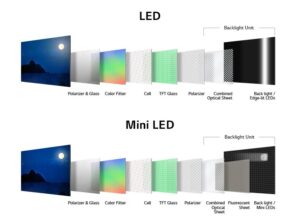This blog contains Amazon affiliate links. If you click on these links and make a purchase, We may earn a small commission at no extra cost to you. This helps support the site and allows us to continue providing helpful content. Thank you for your support!

What is a Mini-LED TV?:
Mini-LED is a display technology that improves the performance of regular LED (Light Emitting Diode) TVs by backlighting them with a huge number of tiny LEDs. The backlight of a conventional LED TV is normally created by a few big LEDs positioned behind the LCD display. The backlighting system of a Mini-LED TV, on the other hand, is made up of thousands of tiny LEDs organised in an array.
Does Mini-LED technology enhance the overall smart tv experience more than LED TV? If yes, how?:
The primary distinction between Mini-LED and LED TVs is the quantity and size of LEDs utilised for illumination. Mini-LED TVs employ much tiny LEDs, generally less than 0.2 mm in size, allowing for a greater number of LEDs to be packed into the display screen. The increased number of LEDs allows for more exact and localised control of the backlighting, resulting in higher contrast, black levels, and overall image quality.
Mini-LEDs’ lower size also aids in the reduction of typical difficulties encountered in LED TVs, such as blooming or halo effects surrounding bright objects on a dark backdrop. Mini-LED TVs may create deeper blacks and eliminate light leakage by separating the lighting into several independently regulated zones.
Furthermore, as compared to standard LED TVs, Mini-LED technology allows for better brightness possibilities. The increased number of LEDs enables more precise brightness control and HDR (High Dynamic Range) performance, resulting in brilliant and lifelike colours with improved highlights and shadows.
It’s vital to distinguish Mini-LED from Micro-LED, a separate display technology that uses small LEDs for each pixel lighting. Micro-LED provides even more control, contrast, and picture quality, but because to its complexity and expense, it is currently found in just a few high-end, large-format displays.
In comparison to regular LED TVs, mini-LED technology does not immediately improve the entire smart TV experience. The software, user interface, and functions provided by the TV’s operating system are crucial to the smart TV experience. Mini-LED and LED TVs may both provide similar smart TV functionality and capabilities.
The primary benefit of mini-LED technology is an improvement in picture quality and display performance. Mini-LED backlighting enables more exact control of local dimming zones, resulting in greater contrast, black levels, and brightness uniformity. This can result in a more immersive and visually pleasant viewing experience, particularly in gloomy environments or with HDR material.
It is crucial to remember, however, that the smart TV experience is not simply dependent on display technology. Other considerations include the operating system, available apps, networking possibilities, and user interface. These factors are unaffected by whether the TV has mini-LED or standard LED illumination.
When shopping for a smart TV, consider the operating system (for example, Android TV, webOS, or Tizen), accessible applications and streaming services, voice control features, ease of navigation, and interoperability with other smart devices. These characteristics will have a greater impact on the entire smart TV experience than the display technology utilised.
In conclusion, while mini-LED technology improves image quality, it does not improve the whole smart TV experience. The software, user interface, and functionality supplied by the TV’s operating system and ecosystem determine the smart TV experience.
Which brands are currently offering mini-LED TVs and what are their unique offerings?:
Several companies are already selling mini-LED TVs, each with its own set of features and capabilities. Some major brands and their mini-LED TV offers are as follows:
Samsung: Samsung sells mini-LED televisions under the Neo QLED brand. These televisions make use of Samsung’s Quantum Mini LED technology, which blends ultra-fine micro layers of LEDs with a thin backlight system. For a full smart TV experience, Samsung’s mini-LED TVs combine enhanced image quality, Quantum HDR technology, powerful CPUs, and their Tizen operating system.
LG: LG has released mini-LED TVs under the LG QNED brand. These televisions use quantum dot technology in conjunction with mini-LED backlighting to provide improved colour reproduction and local dimming. LG’s mini-LED TVs have the AI Processor 9 Gen 4, Dolby Vision IQ, webOS smart platform, and other sophisticated features including HDMI 2.1 connectivity and gaming-centric settings.
TCL: TCL sells mini-LED TVs under the Mini-LED QLED brand. TCL’s mini-LED backlighting technology is integrated with quantum dot colour technology in these TVs. TCL’s mini-LED TVs include a high contrast ratio, a wide colour gamut, and a proprietary AiPQ Engine for enhanced image quality. They also have the Roku TV platform for an easy-to-use smart TV experience.
Hisense: As part of their ULED portfolio, Hisense has produced mini-LED TVs. Hisense’s ULED XD technology is used in these TVs, which combines a dual-cell screen with mini-LED illumination. Hisense’s mini-LED TVs provide better contrast and colour accuracy, as well as access to major streaming services via the VIDAA U smart platform.
Sony: Sony’s MASTER Series TVs have joined the mini-LED market. These TVs include full-array local dimming with fine control over mini-LED backlighting zones and Sony’s Cognitive Processor XR for sophisticated picture processing. Sony’s mini-LED TVs provide high-quality graphics, support for multiple HDR formats, and an Android TV platform for a complete smart TV experience.
What is the future potential of mini-LED technology in the TV market?:
Mini-LED technology has a lot of potential for the future of the television market. Its promise rests in improving image quality, improving HDR performance, allowing for thinner designs, evolving local dimming capabilities, manufacturing developments, integrating with other display technologies, and moving into commercial and professional applications.
One of the primary benefits of mini-LED technology is its potential to improve image quality. Mini-LED TVs may offer deeper blacks, greater contrast ratios, and improved brightness uniformity with fine control over local dimming zones. As a consequence, the viewing experience becomes more immersive, with more accurate colour reproduction, a broader colour range, and finer details.
Furthermore, mini-LED backlighting boosts HDR performance greatly. Mini-LED technology enables for a more realistic and dynamic HDR experience by providing increased brightness levels and precise dimming zones. Brighter highlights and more complex shadow details can be enjoyed by viewers, boosting the overall visual impact of HDR material.
Local dimming is also evolving as a result of mini-LED technology. Manufacturers may increase the number of dimming zones as mini-LEDs get smaller and more densely packed, resulting in greater control over brightness levels and higher backlight accuracy. This breakthrough leads in better contrast, less blooming, and more localised control over lighting in various sections of the screen.
Mini-LED technology may also be integrated with other display technologies, such as quantum dots, to improve colour accuracy and volume. The combination of mini-LED technology with other improvements in panel technology, such as OLED or Micro-LED, has the potential to create even more advanced and novel display solutions in the future.
Mini-LED technology has uses outside of consumer televisions, such as commercial displays, professional monitors, and high-end gaming monitors. Mini-LED is an appealing alternative for professional users that want accurate colour reproduction and high visual performance because to its improved picture quality, precise local dimming, and HDR capabilities.


Comments are closed